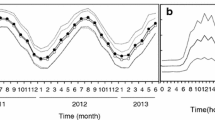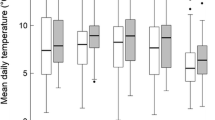Abstract
Over the coming decades, the Arctic is expected to experience warming temperatures and variable changes in the timing of snowmelt. Both temperature and the timing of snowmelt are important drivers of phenology and reproduction on the tundra. However, few studies have considered their combined effects, making it difficult to predict the direction and magnitude of Arctic plant responses to changing climates. In this 1-year study, we examine how temperature and delayed snowmelt jointly impact the phenology and reproductive effort/success of four common heath tundra species: Empetrum nigrum L., Rhododendron lapponicum (L.) Wahlenb., Dryas integrifolia Vahl, and Arctostaphylos rubra Fernald. We erected snow fences during the winter to increase snowpack on six plots (paired with six control plots), resulting in a consistent 10-day delay in the timing of snowmelt. During the subsequent growing season, we tracked how temperature and the delayed snowmelt on the treatment plots affected the day of onset of species’ phenophases, as well as their ability to flower and set fruit. Both temperature and snow addition were significant drivers of phenological onset in these species, though species showed different sensitivities to these factors, possibly as a result of differences in life history strategies. In addition, two of the four species responded positively to snow addition in terms of reproductive effort. Our results emphasize the importance of considering the simultaneous effects of the multiple drivers of Arctic plant phenology.





Similar content being viewed by others
References
Aerts R, Cornelissen J, Dorrepaal E et al (2004) Effects of experimentally imposed climate scenarios on flowering phenology and flower production of subarctic bog species. Glob Change Biol 10:1599–1609
AMAP (2012) Arctic climate issues 2011: changes in Arctic snow, water, ice and permafrost. SWIPA 2011 overview report. Arctic Monitoring and Assessment Programme (AMAP)
Arft A, Walker M, Gurevitch J (1999) Responses of tundra plants to experimental warming: meta-analysis of the international tundra experiment. Ecol Monogr 69:491–511
Bates D, Maechler M, Bolker B et al (2014) lme4: mixed-effects modelling with R. R package version 1.1-7. http://cran.r-project.org/web/packages/lme4/index.html. Accessed 10 Oct 2014
Bokhorst SF, Bjerke JW, Tømmervik H et al (2009) Winter warming events damage sub-Arctic vegetation: consistent evidence from an experimental manipulation and a natural event. J Ecol 97:1408–1415
Borner A, Kielland K, Walker M (2008) Effects of simulated climate change on plant phenology and nitrogen mineralization in Alaskan Arctic tundra. Arct Antarct Alp Res 40:27–38
Chapin FS III, Shaver G, Giblin A, Nadelhoffer KJ, Laundre JA (1995) Responses of Arctic tundra to experimental and observed changes in climate. Ecology 76:694–711
Cooper EJ, Dullinger S, Semenchuk P (2011) Late snowmelt delays plant development and results in lower reproductive success in the High Arctic. Plant Sci 180:157–167
Dawes MA, Hagedorn F, Zumbrunn T et al (2011) Growth and community responses of alpine dwarf shrubs to in situ CO2 enrichment and soil warming. New Phytol 191:806–818
Dorji T, Totland Ø, Moe SR et al (2013) Plant functional traits mediate reproductive phenology and success in response to experimental warming and snow addition in Tibet. Glob Change Biol 19:459–472
Dunne JA, Harte J, Taylor KJ (2003) Subalpine meadow flowering phenology responses to climate change: integrating experimental and gradient methods. Ecol Monogr 73:69–86
Ellebjerg SM, Tamstorf MP, Illeris L et al (2008) Inter-annual variability and controls of plant phenology and productivity at Zackenberg. Adv Ecol Res 40:249–273
Elmendorf SC, Henry GHR, Hollister RD et al (2012a) Global assessment of experimental climate warming on tundra vegetation: heterogeneity over space and time. Ecol Lett 15:164–175
Elmendorf SC, Henry GHR, Hollister RD et al (2012b) Plot-scale evidence of tundra vegetation change and links to recent summer warming. Nat Clim Change 2:453–457
Hill GB, Henry GHR (2011) Responses of High Arctic wet sedge tundra to climate warming since 1980. Glob Change Biol 17:276–287
Hofgaard A, Løkken JO, Dalen L, Hytteborn H (2010) Comparing warming and grazing effects on birch growth in an alpine environment—a 10-year experiment. Plant Ecol Divers 3:19–27
Hollister R, Webber P, Bay C (2005) Plant response to temperature in Northern Alaska: implications for predicting vegetation change. Ecology 86:1562–1570
Hudson JMG, Henry GHR (2010) High Arctic plant community resists 15 years of experimental warming. J Ecol 98:1035–1041
Klanderud K, Totland Ø (2005) Simulated climate change altered dominance hierarchies and diversity of an alpine biodiversity hotspot. Ecology 86:2047–2054
Klein JA, Harte J, Zhao X (2004) Experimental warming causes large and rapid species loss, dampened by simulated grazing, on the Tibetan Plateau. Ecol Lett 7:1170–1179
Klein JA, Harte J, Zhao X (2008) Decline in medicinal and forage species with warming is mediated by plant traits on the Tibetan Plateau. Ecosystems 11:775–789
Legault G, Weis AR (2013) The impact of snow accumulation on a heath spider community in a sub-Arctic landscape. Polar Biol 36:885–894
Liu Y, Reich P, Li G, Sun S (2011) Shifting phenology and abundance under experimental warming alters trophic relationships and plant reproductive capacity. Ecology 92:1201–1207
Markus T, Stroeve J, Miller J (2009) Recent changes in Arctic sea ice melt onset, freezeup, and melt season length. J Geophys Res Oceans 114:C12024
Molau U (1993) Relationships between flowering phenology and life history strategies in tundra plants. Arct Alp Res 25:391–402
Molau U, Nordenhäll U, Eriksen B (2005) Onset of flowering and climate variability in an alpine landscape: a 10-year study from Swedish Lapland. Am J Bot 92:422–431
Myers-Smith IH, Forbes BC, Wilmking M et al (2011) Shrub expansion in tundra ecosystems: dynamics, impacts and research priorities. Environ Res Lett 6:045509
Oberbauer S, Elmendorf SC, Troxler T et al (2013) Phenological response of tundra plants to background climate variation tested using the International Tundra Experiment. Philos Trans R Soc B Biol Sci 368:20120481
Olsson P, Sturm M (2003) Five stages of the Alaskan Arctic cold season with ecosystem implications. Arct Antarct Alp Res 35:74–81
Post E, Pedersen C (2008) Opposing plant community responses to warming with and without herbivores. Proc Natl Acad Sci USA 105:12353–12358
Rafferty NE, Ives AR (2011) Effects of experimental shifts in flowering phenology on plant-pollinator interactions. Ecol Lett 14:69–74
Rumpf S, Semenchuk PR, Dullinger S, Cooper EJ (2014) Idiosyncratic responses of high Arctic plants to changing snow regimes. PLoS ONE 9(2):e86281
Scott P, Rouse W (1995) Impacts of increased winter snow cover on upland tundra vegetation: a case example. Clim Res 5:25–30
Semenchuk PR, Elberling B, Cooper EJ (2013) Snow cover and extreme winter warming events control flower abundance of some, but not all species in high Arctic Svalbard. Ecol Evol 3:2586–2599
Serreze M, Walsh J, Chapin FS III (2000) Observational evidence of recent change in the northern high-latitude environment. Clim Change 46:159–207
Shaver G, Bret-Harte M, Jones M (2001) Species composition interacts with fertilizer to control long-term change in tundra productivity. Ecology 82:3163–3181
Smith J, Sconiers W, Spasojevic MJ et al (2012) Phenological changes in alpine plants in response to increased snowpack, temperature, and nitrogen. Arct Antarct Alp Res 44:135–142
Starr G, Oberbauer SF, Pop E (2000) Effects of lengthened growing season and soil warming on the phenology and physiology of Polygonum bistorta. Glob Change Biol 6:357–369
Stinson K (2005) Effects of snowmelt timing and neighbor density on the altitudinal distribution of Potentilla diversifolia in western Colorado, USA. Arct Antarct Alp Res 37:379–386
Sturm M, McFadden J, Liston G et al (2001) Snow-shrub interactions in Arctic tundra: a hypothesis with climatic implications. J Clim 14:336–344
Tape K, Sturm M, Racine C (2006) The evidence for shrub expansion in Northern Alaska and the Pan-Arctic. Glob Change Biol 12:686–702
Thórhallsdóttir T (1998) Flowering phenology in the central highland of Iceland and implications for climatic warming. Oecologia 114:43–49
Wahren CH, Walker MD, Bret-Harte MS (2005) Vegetation responses in Alaskan Arctic tundra after 8 years of a summer warming and winter snow manipulation experiment. Glob Change Biol 11:537–552
Walker M, Walker D, Welker J (1999) Long-term experimental manipulation of winter snow regime and summer temperature in Arctic and alpine tundra. Hydrol Process 13:2315–2330
Walker MD, Wahren CH, Hollister RD et al (2006) Plant community responses to experimental warming across the tundra biome. Proc Natl Acad Sci USA 103:1342–1346
Wang S, Duan J, Xu G et al (2012) Effects of warming and grazing on soil N availability, species composition, and ANPP in an alpine meadow. Ecology 93:2365–2376
Wipf S (2010) Phenology, growth, and fecundity of eight subArctic tundra species in response to snowmelt manipulations. Plant Ecol 207:53–66
Wipf S, Rixen C (2010) A review of snow manipulation experiments in Arctic and alpine tundra ecosystems. Polar Res 29:95–109
Wipf S, Rixen C, Mulder CPH (2006) Advanced snowmelt causes shift towards positive neighbour interactions in a subArctic tundra community. Glob Change Biol 12:1496–1506
Xu L, Myneni RB, Chapin FS III et al (2013) Temperature and vegetation seasonality diminishment over northern lands. Nat Clim Chang 3:581–586
Acknowledgments
This work was supported by a Grant from the Northern Scientific Training Program (Aboriginal Affairs and Northern Development Canada) and an NSERC Northern Research Internship to Marine Cusa. We thank LeeAnn Fishback, Carley Basler, and the Churchill Northern Studies Centre for crucial logistical and financial support. We also thank four anonymous reviewers for their valuable feedback. Special thanks to Everest T and Caroline Tucker for thoughtful comments on the manuscript.
Author information
Authors and Affiliations
Corresponding author
Electronic supplementary material
Below is the link to the electronic supplementary material.
Rights and permissions
About this article
Cite this article
Legault, G., Cusa, M. Temperature and delayed snowmelt jointly affect the vegetative and reproductive phenologies of four sub-Arctic plants. Polar Biol 38, 1701–1711 (2015). https://doi.org/10.1007/s00300-015-1736-6
Received:
Revised:
Accepted:
Published:
Issue Date:
DOI: https://doi.org/10.1007/s00300-015-1736-6




